Graphene-Based THz Absorber with a Broad Band for Tuning the Absorption Rate and a Narrow Band for Tuning the Absorbing Frequency
Abstract
:1. Introduction
2. Materials and Methods
3. Results
3.1. Simulations of the Broadband Absorption-Controllable Absorber
3.2. Simulations of The Narrowband Frequency-Tunable Absorber
3.3. Simulations of Independently Tunable Dual-Band Absorber
4. Conclusions
Author Contributions
Funding
Conflicts of Interest
References
- Kleine-ostmann, T.; Nagatsuma, T. A review on terahertz communications research. J. Infrared Millim. Terahz. Waves 2011, 32, 143–171. [Google Scholar] [CrossRef]
- Hu, B.B.; Nuss, M.C. Imaging with terahertz waves. Opt. Lett. 1995, 20, 1716–1718. [Google Scholar] [CrossRef] [PubMed]
- O’Hara, J.F.; Withayachumnankul, W.; Al-naib, I. A review on thin-film sensing with terahertz waves. J. Infrared Millim. Terahz. Waves 2012, 33, 245–291. [Google Scholar] [CrossRef]
- Hangyo, M.; Tani, M.; Nagashima, T. Terahertz time-domain spectroscopy of solids: A review. J. Infrared Millim. Terahz. Waves 2005, 26, 1661–1690. [Google Scholar] [CrossRef]
- Libon, I.H.; Baumgärtner, S.; Hempel, M.; Hecker, N.E.; Feldmann, J.; Koch, M.; Dawson, P. An optically controllable terahertz filter. Appl. Phys. Lett. 2000, 76, 2821–2823. [Google Scholar] [CrossRef]
- Fan, R.; Zhou, Y.; Ren, X.; Peng, R.; Jiang, S.; Xu, D.; Xiong, X.; Huang, X.; Wang, M. Freely tunable broadband polarization rotator for terahertz waves. Adv. Mater. 2015, 27, 1201–1206. [Google Scholar]
- Tao, H.; Bingham, C.M.; Strikwerda, A.C.; Pilon, D.; Shrekenhamer, D.; Landy, N.I.; Fan, K.; Zhang, X.; Padilla, W.J.; Averitt, R.D. Highly flexible wide angle of incidence terahertz metamaterial absorber: Design, fabrication, and characterization. Phys. Rev. B Condens. Matter Mater. Phys. 2008, 78, 2–5. [Google Scholar] [CrossRef]
- Zhang, Y.; Feng, Y.; Zhu, B.; Zhao, J.; Jiang, T. Graphene based tunable metamaterial absorber and polarization modulation in terahertz frequency. Opt. Express 2014, 22, 22743. [Google Scholar] [CrossRef] [PubMed]
- Liu, M.H.; Gorini, C.; Richter, K. Creating and steering highly directional and electron beams in graphene. Phys. Rev. Lett. 2017, 118, 066801. [Google Scholar] [CrossRef]
- Pasanen, P.; Voutilainen, M.; Helle, M.; Song, X.; Hakonen, P.J. Graphene for future electronics. Appl. Phys. Lett. 2016, 95, 061101. [Google Scholar] [CrossRef]
- Zhou, Q.; Liu, P.; Bian, L.A.; Liu, H.; Liu, C.; Chen, G. Controlling enhanced absorption in graphene metamaterial. Opt. Commun. 2018, 413, 310–316. [Google Scholar] [CrossRef]
- Bartolomeo, A.D.; Giubileo, F.; Santandrea, S.; Romeo, F.; Citro, R.; Schroeder, T.; Lupina, G. Charge transfer and partial pinning at the contacts as the origin of a double dip in the transfer characteristics of graphene-based field-effect transistors. Nanotechnology 2011, 22, 275702. [Google Scholar] [CrossRef] [PubMed] [Green Version]
- Ye, L.; Chen, Y.; Cai, G.; Liu, N.; Zhu, J.; Song, Z.; Liu, Q.H. Broadband absorber with periodically sinusoidally-patterned graphene layer in terahertz range. Opt. Express 2017, 25, 11223. [Google Scholar] [CrossRef] [PubMed]
- Chen, P.Y.; Farhat, M.; Bağcı, H. Graphene metascreen for designing compact infrared absorbers with enhanced bandwidth. Nanotechnology 2015, 26, 164002. [Google Scholar] [CrossRef] [PubMed]
- Zhao, Y.; Wu, B.; Huang, B.; Cheng, Q. Switchable broadband terahertz absorber/reflector enabled by hybrid graphene-gold metasurface. Opt. Express 2017, 25, 7161. [Google Scholar] [CrossRef] [PubMed]
- Jadidi, M.M.; Sushkov, A.B.; Myers-Ward, R.L.; Boyd, A.K.; Daniels, K.M.; Gaskill, D.K.; Fuhrer, M.S.; Drew, H.D.; Murphy, T.E. Tunable terahertz hybrid metal-graphene. Plasmon. Nano Lett. 2015, 15, 7099–7104. [Google Scholar] [CrossRef]
- Guo, X.; Hu, H.; Liao, B.; Zhu, X.; Yang, X.; Dai, Q. Perfect-absorption graphene metamaterials for surface-enhanced molecular fingerprint spectroscopy. Nanotechnology 2018, 29, 184004. [Google Scholar] [CrossRef]
- Yao, G.; Ling, F.; Yue, J.; Luo, C.; Ji, J.; Yao, J. Dual-band tunable perfect metamaterial absorber in the THz range. Opt. Express 2016, 24, 1518–1527. [Google Scholar] [CrossRef]
- Zhou, Q.; Liu, P.; Bian, L.; Cai, X.; Liu, H. Multi-band terahertz absorber exploiting graphene metamaterial. Opt. Mater. Express 2018, 8, 2928–2940. [Google Scholar] [CrossRef]
- Liu, B.; Tang, C.; Chen, J.; Wang, Q.; Pei, M.; Tang, H. Dual-band light absorption enhancement of monolayer graphene from surface plasmon polaritons and magnetic dipole resonances in metamaterials. Opt. Express 2017, 25, 12061–12068. [Google Scholar] [CrossRef]
- Amin, M.; Farhat, M.; Bağcı, H. An ultra-broadband multilayered graphene absorber. Opt. Express 2013, 21, 29938–29948. [Google Scholar] [CrossRef] [PubMed]
- Guo, W.; Liu, Y.; Han, T. Ultra-broadband infrared metasurface absorber. Opt. Express 2016, 24, 20586. [Google Scholar] [CrossRef] [PubMed]
- Yi, S.; Zhou, M.; Shi, X.; Gan, Q.; Zi, J.; Yu, Z. A multiple-resonator approach for broadband light absorption in a single layer of nanostructured graphene. Opt. Express 2015, 23, 10081. [Google Scholar] [CrossRef] [PubMed]
- Huang, X.; He, W.; Yang, F.; Ran, J.; Gao, B.; Zhang, W. Polarization-independent and angle-insensitive broadband absorber with a target-patterned graphene layer in the terahertz regime. Opt. Express 2018, 26, 25558–25566. [Google Scholar] [CrossRef] [PubMed]
- Mou, N.; Sun, S.; Dong, H.; Dong, S.; He, Q.; Zhou, L.; Zhang, L. Hybridization-induced broadband terahertz wave absorption with graphene metasurfaces. Opt. Express 2018, 26, 7181–7188. [Google Scholar] [CrossRef] [PubMed]
- Xiao, S.; Wang, T.; Liu, T.; Yan, X.; Li, Z.; Xu, C. Active modulation of electromagnetically induced transparency analogue in terahertz hybrid metal-graphene metamaterials. Carbon 2018, 126, 271–278. [Google Scholar] [CrossRef] [Green Version]
- Zhou, Q.; Zha, S.; Liu, P.; Liu, C.; Bian, L.; Zhang, J.; Liu, H.; Ding, L. Graphene based controllable broadband terahertz metamaterial absorber with transmission band. Materials 2018, 11, 2049. [Google Scholar] [CrossRef] [PubMed]
- Hanson, G.W. Dyadic green’s functions for an anisotropic, non-local model of biased graphene. IEEE Trans. Antenn. Propag. 2008, 56, 747–757. [Google Scholar] [CrossRef]
- Llatser, I.; Kremers, C.; Cabellos-Aparicio, A.; Jornet, J.M.; Alarcón, E.; Chigrin, D.N. Graphene-based nano-patch antenna for terahertz radiation. Photonics Nanostruct. Fundam. Appl. 2012, 10, 353–358. [Google Scholar] [CrossRef] [Green Version]
- Tymchenko, M.; Nikitin, A.Y.; Martín-Moreno, L. Faraday rotation due to excitation of magnetoplasmons in graphene. ACS Nano 2013, 7, 9780–9787. [Google Scholar] [CrossRef]
- Vasic, B.; Jakovljevic, M.M.; Isic, G.; Gajic, R. Tunable metamatrials based on split ring resonators and doped graphene. Appl. Phys. Lett. 2013, 103, 011102. [Google Scholar] [CrossRef]
- Sensale-Rodriguez, B.; Yan, R.; Rafique, S.; Zhu, M.; Li, W.; Liang, X.; Gundlach, D.; Protasenko, V.; Kelly, M.M.; Jena, D.; et al. Extraordinary control of terahertz beam reflectance in graphene electro-absorption modulators. Nano Lett. 2012, 12, 4518–4522. [Google Scholar] [CrossRef] [PubMed]
- Ren, L.; Zhang, Q.; Yao, J.; Sun, Z.; Kaneko, R.; Yan, Z.; Nanot, S.; Jin, Z.; Kawayama, I.; Tonouchi, M.; et al. Terahertz and infrared spectroscopy of gated large-area graphene. Nano Lett. 2012, 12, 3711–3715. [Google Scholar] [CrossRef] [PubMed]
- Liu, C.; Liu, P.; Yang, C.; Lin, Y.; Liu, H. Analogue of dual-controlled electromagnetically induced transparency based on graphene metamaterial. Carbon 2019, 142, 354–362. [Google Scholar] [CrossRef]
- He, X.; Zhong, X.; Lin, F.; Shi, W. Investigation of graphene assisted tunable terahertz metamaterials absorber. Opt. Mater. Express 2016, 6, 331–342. [Google Scholar] [CrossRef]
- Zhou, Q.; Zha, S.; Bian, L.A.; Zhang, J.; Ding, L.; Liu, H.; Liu, P. Independently controllable dual-band terahertz metamaterial absorber exploiting graphene. J. Phys. D Appl. Phys. 2019, 52, 255102. [Google Scholar] [CrossRef]
- Su, Z.; Yin, J.; Zhao, X. Terahertz dual-band metamaterial absorber based on graphene/MgF2 multilayer structures. Opt. Express 2015, 23, 1679. [Google Scholar] [CrossRef]
- Ordal, M.A.; Bell, R.J.; Alexander, R.W.; Long, L.L.; Querry, M.R. Optical properties of fourteen metals in the infrared and far infrared: Al, Co, Cu, Au, Fe, Pb, Mo, Ni, Pd, Pt, Ag, Ti, V, and W. Appl. Opt. 1985, 24, 4493–4499. [Google Scholar] [CrossRef]
- Ebrahimi, A.; Shen, Z.; Withayachumnankul, W.; Al-Sarawi, S.F.; Abbott, D. Varactor-tunable second-order bandpass frequency-selective surface with embedded bias network. IEEE Trans. Antennas Propag. 2016, 64, 1672–1680. [Google Scholar] [CrossRef]
- Zhou, Q.; Liu, P.; Wang, K.; Liu, H.; Yu, D. Absorptive frequency selective surface with switchable passband. AEU Int. J. Electron. Commun. 2018, 89, 160–166. [Google Scholar] [CrossRef]
- CST Microwave Studio by Computer Simulation Technology. Available online: http://www.cst.com (accessed on 20 June 2019).
- Munk, B.A. Frequency Selective Surfaces: Theory and Design; John Wiley & Sons: Hoboken, NJ, USA, 2005. [Google Scholar]
- Tao, H.; Landy, N.I.; Bingham, C.M.; Zhang, X.; Averitt, R.D.; Padilla, W.J. A metamaterial absorber for the terahertz regime: Design, fabrication and characterization. Opt. Express 2008, 16, 7181–7188. [Google Scholar] [CrossRef] [PubMed]
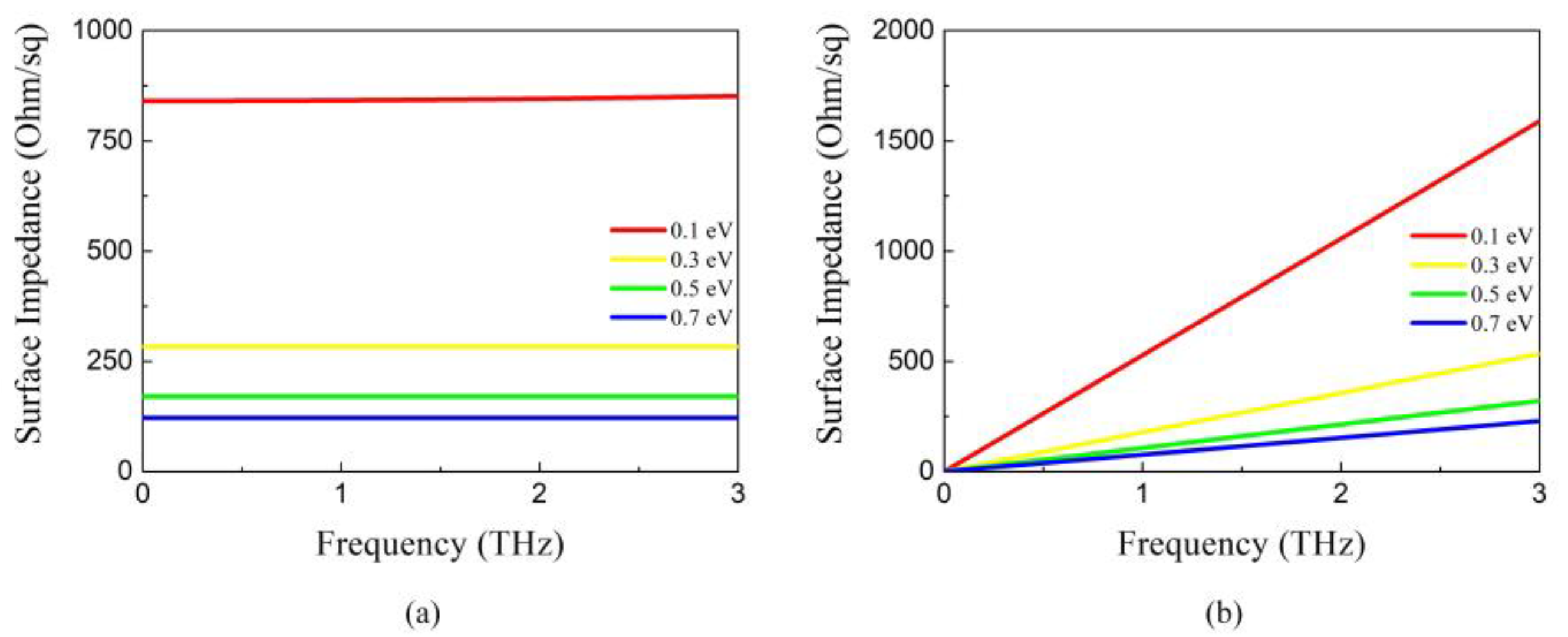

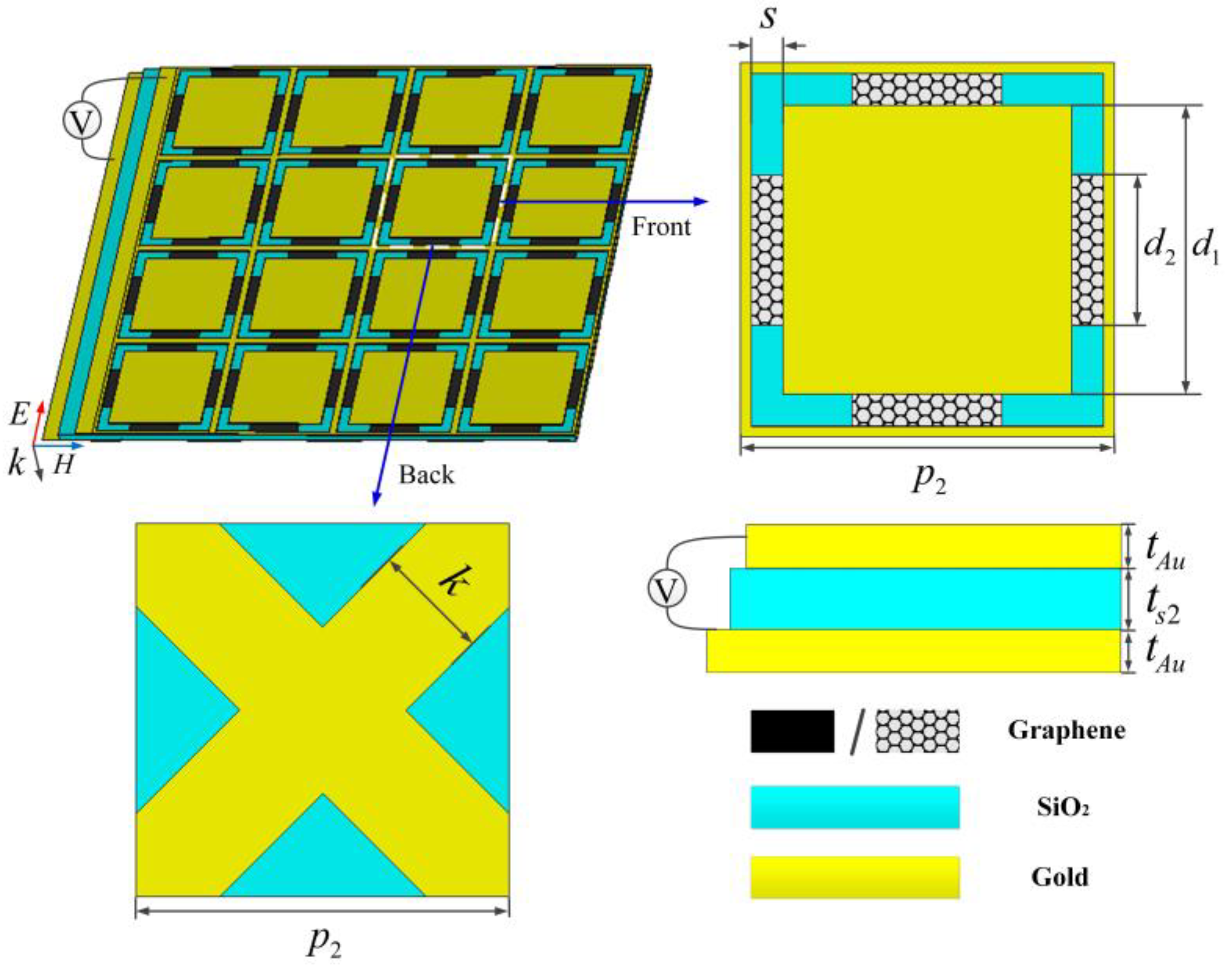


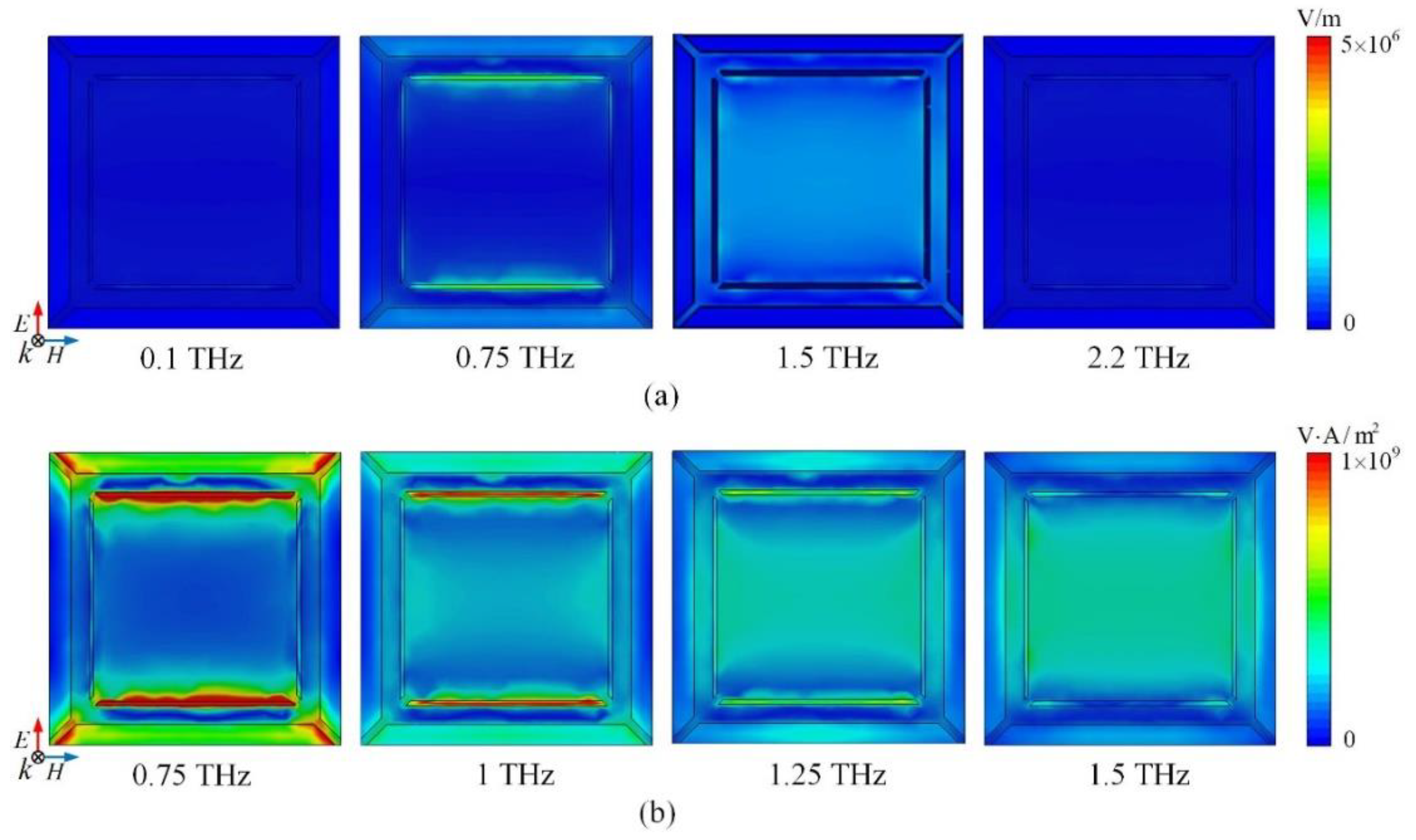


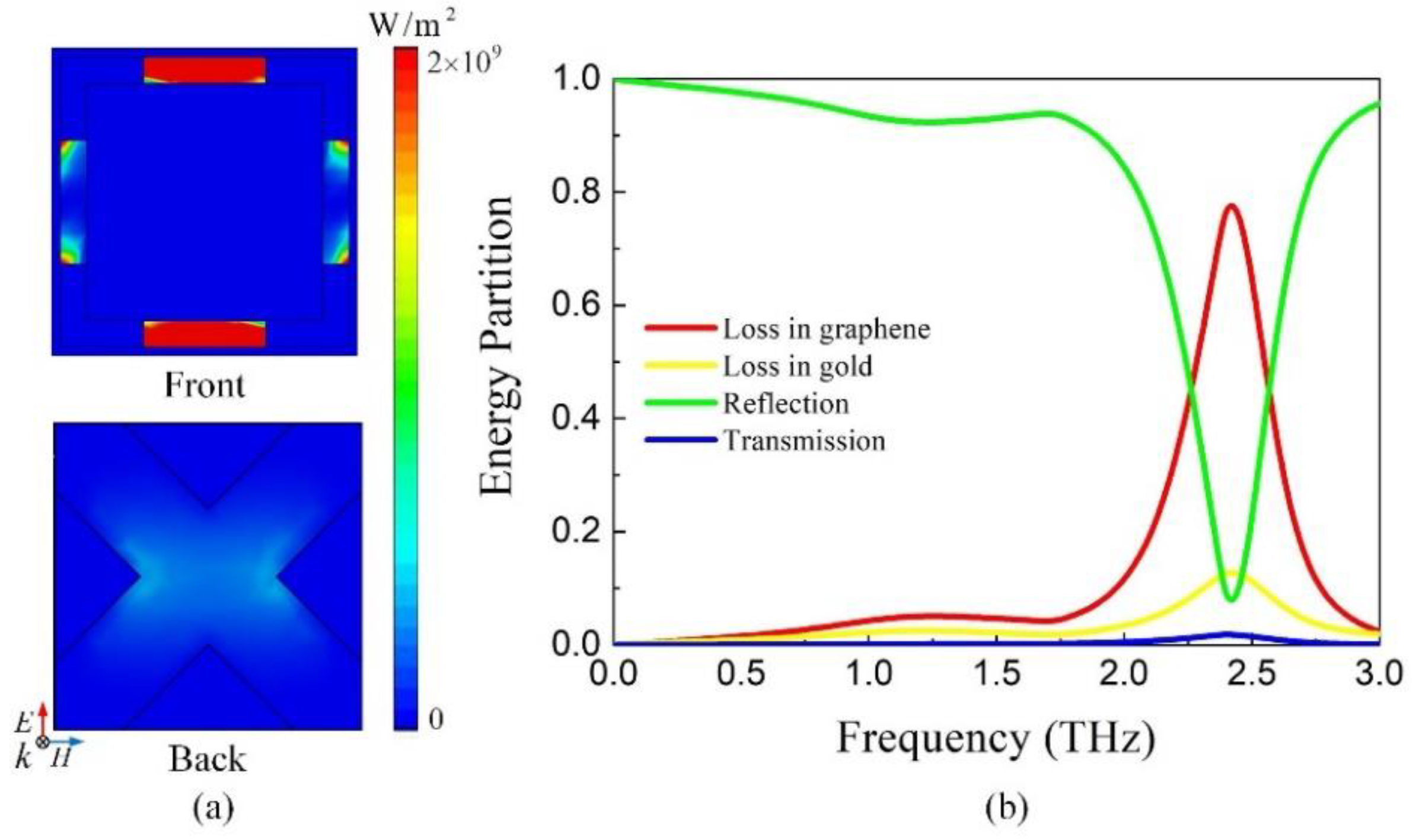
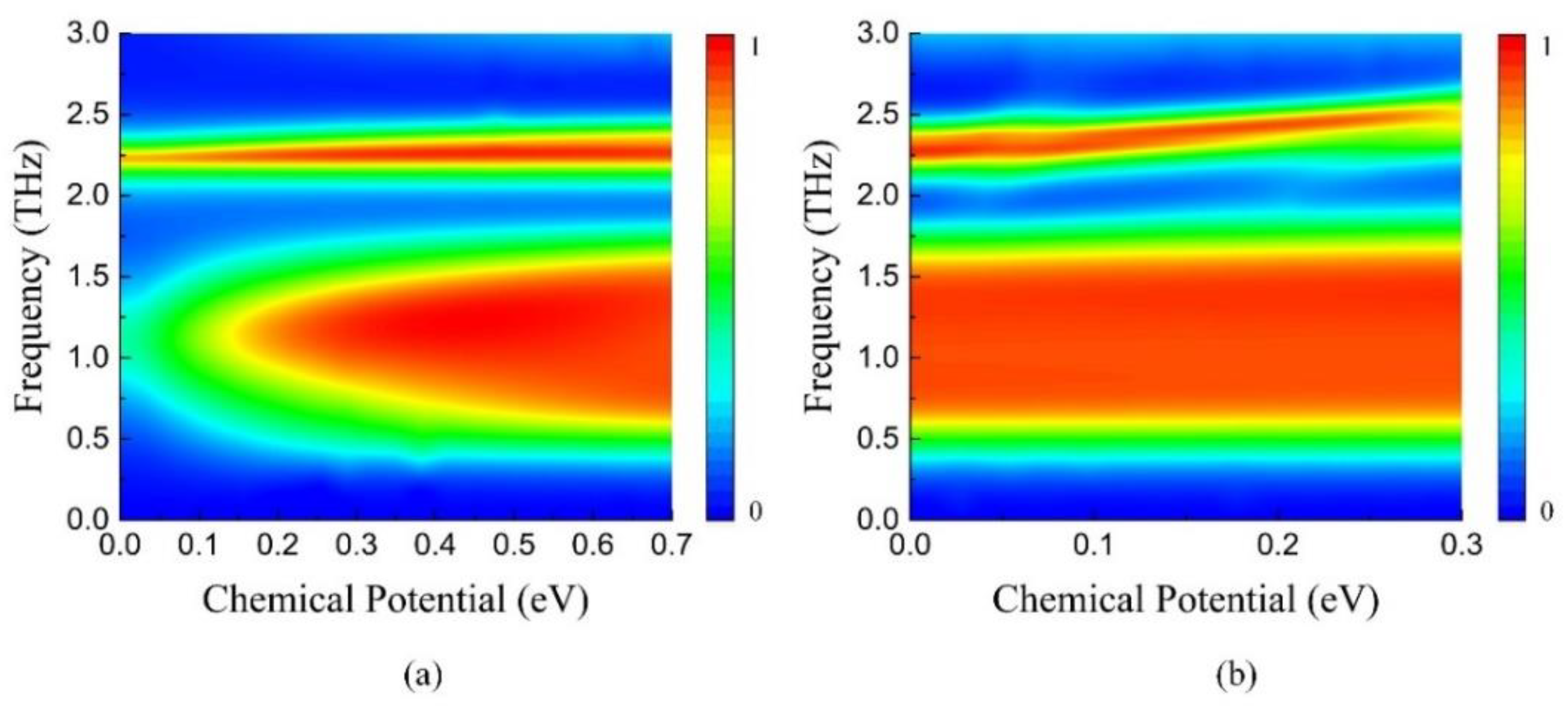

© 2019 by the authors. Licensee MDPI, Basel, Switzerland. This article is an open access article distributed under the terms and conditions of the Creative Commons Attribution (CC BY) license (http://creativecommons.org/licenses/by/4.0/).
Share and Cite
Zhou, Q.; Liu, P.; Liu, C.; Zhou, Y.; Zha, S. Graphene-Based THz Absorber with a Broad Band for Tuning the Absorption Rate and a Narrow Band for Tuning the Absorbing Frequency. Nanomaterials 2019, 9, 1138. https://doi.org/10.3390/nano9081138
Zhou Q, Liu P, Liu C, Zhou Y, Zha S. Graphene-Based THz Absorber with a Broad Band for Tuning the Absorption Rate and a Narrow Band for Tuning the Absorbing Frequency. Nanomaterials. 2019; 9(8):1138. https://doi.org/10.3390/nano9081138
Chicago/Turabian StyleZhou, Qihui, Peiguo Liu, Chenxi Liu, Yuandong Zhou, and Song Zha. 2019. "Graphene-Based THz Absorber with a Broad Band for Tuning the Absorption Rate and a Narrow Band for Tuning the Absorbing Frequency" Nanomaterials 9, no. 8: 1138. https://doi.org/10.3390/nano9081138




